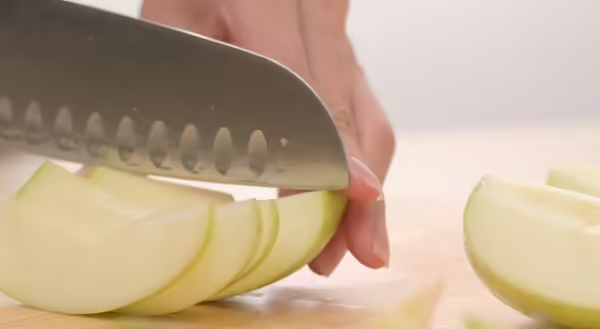
Apples are a fruit available all year, but taste the best when freshly picked from a local orchard or picked up at a farmers markets in the fall. Whether making apple butter, sauce, pie, salad, drying, freezing, canning, or cutting them up to snack on later, one universal struggle is slicing them fast enough before they start turning brown. Working against the clock in the kitchen to peel and prepare apples before they start browning can feel stressful.
Apples, bananas, peaches, and pears are just a few fruits that turn brown when cut open. The fruit’s exposure to air causes enzymatic browning. Browning is harmless, but the fruit loses its crisp texture and doesn't look appealing.
Depending on whether you are preserving apples for later use or baking them, this may determine what type of pre-treatment to use. Freezing and canning may require a less concentrated pre-treatment solution compared to drying cut apples. The darkening of apples can be stopped in a few different ways:
- Ascorbic Acid Tablets or Mixture. Ascorbic acid, commonly known as vitamin C, can be found in the grocery store or pharmacy. Using ascorbic acid does not add flavor to the apples. Mix 1 teaspoon powder or six crushed tablets (500 mg. per tablet) with 2 cups of water and dip apples in the solution for 3 to 5 minutes. The ascorbic acid powder can also be added directly to the fruit and mixed. The white specks in the tablets are harmless. Follow manufacturer's instruction for using ascorbic acid mixtures, such as Fruit-Fresh, commonly made of a mix of ascorbic and citric acid with a sugar base.
- Fruit Juice Dip. Grape, orange, lemon, lime, and pineapple juice can all slow down browning with their higher concentrations of vitamin C. Keep in mind, adding juice may change the flavor or color of the apple product as well. A suggestion to reduce the flavor change is to mix 1-quart water with three tablespoons of lemon juice and soak apples for 3 to 5 minutes.
- Honey Dip. Another method for preventing browning is creating a honey solution made of 1/2 cup sugar, one-half cup honey, and 1 1/2 cup boiling water. Soak fruit for 3 to 5 minutes and drain. This method does add extra calories.
Citric acid alone is not a good substitute for ascorbic acid to prevent browning. Another option is using sodium bisulfate which should not be used for individuals with asthma. Sodium bisulfite or sulfite dip is the most effective treatment for long term storage of dried apples. Sodium bisulfate can be ordered through a local pharmacy.
Do not leave cut apples out at room temperature for more than two hours. Pre-treated apples should be wrapped tightly in plastic wrap or placed in a covered air-tight container in the refrigerator. Cut, pretreated apples can last about three to four days in the refrigerator depending on apple variety.
Have additional questions about keeping apples fresh? Contact the local Extension office, visit University of Illinois Extension’s Apples & More Website, or join Extension Nutrition and Wellness educators on July 15 as they share tips on canning, freezing, drying, and cooking a variety of apples.
SOURCE: Lisa Peterson is a Nutrition and Wellness Educator serving Christian, Jersey, Macoupin, and Montgomery Counties.
Reference:
Harris, Linda J, et al. Apples: Safe Methods to Store, Preserve, and Enjoy. University of California, 2007.
Riggs, Kathleen, et al. Preserve Your Harvest: Apples. Utah State University Cooperative Extension. 2010.